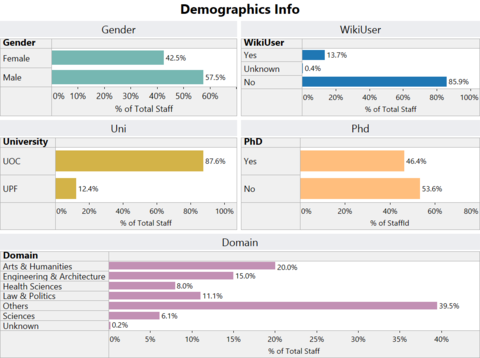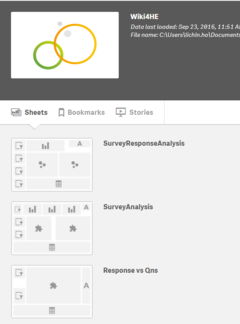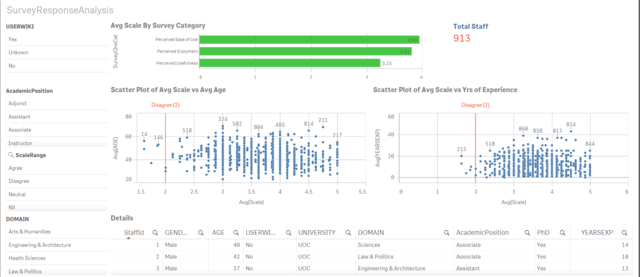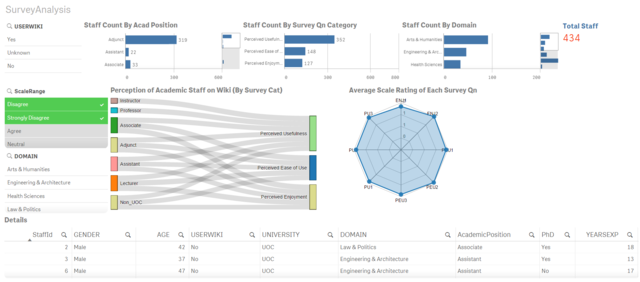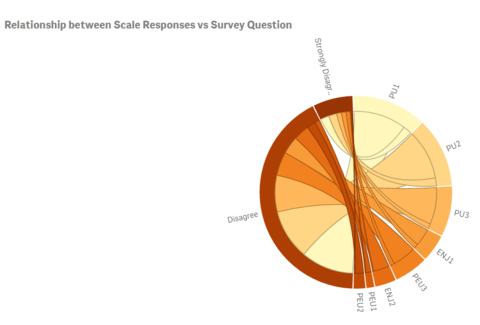ISSS608 2016-17 T1 Assign2 Ho Li Chin
Contents
- 1 Abstract
- 2 Theme of Interest
- 3 Examine the Survey Questions
- 4 Questions for Investigation
- 5 Analysis of Wiki For Higher Education Dataset through Visualisation
- 6 Tools Used
- 7 Conclusion
Abstract
In this assignment, the interactive data exploration and the analysis techniques will be applied to discovery patterns in multivariate data.
Theme of Interest
In this assignment, the dataset that have been chosen for the analysis is “wiki4HE Data Set” (https://archive.ics.uci.edu/ml/datasets/wiki4HE).
The theme of interest is to explore the factors affecting the use of Wikipedia in Higher Education. Wiki technology emerged in higher education teaching and learning experiences as early as 1999 and is integrated into many courses for its ability to provide a collaborative environment for Academic staff and students.
The objective of this assignment is to understand the main factors that influence the teaching uses of Wikipedia among university faculty staff, and any of those factors have significant direct impact on the Behavioral Intention of adopting Wikipedia in higher education, for providing more effective and efficient methods to maximize the teaching and learning experience.
Examine the Survey Questions
In this section, we will first examine the survey questions in the dataset. The survey questions are categorized into respective broader category, and each category is mapped to one construct measure for investigation purpose. These measures will be considered to further derive the investigation questions in next section for the purpose of the analysis.
| Survey Question Category | Survey Questions (Variables) | Measures |
|---|---|---|
| Perceived Usefulness | PU1: The use of Wikipedia makes it easier for students to develop new skills.
PU2: The use of Wikipedia improves students' learning |
User perception of technological innovations using wiki technology |
| Perceived Ease of Use | PEU1: Wikipedia is user friendly
PEU2: It is easy to find in Wikipedia the information you seek PEU3: It is easy to add or edit information in Wikipedia |
User perception of technological innovations using wiki technology |
| Perceived Enjoyment | ENJ1: The use of Wikipedia stimulates curiosity
ENJ2: The use of Wikipedia is entertaining |
User perception of technological innovations using wiki technology |
| Use behaviour | USE1: I use Wikipedia to develop my teaching materials
USE2: I use Wikipedia as a platform to develop educational activities with students USE3: I recommend my students to use Wikipedia USE4: I recommend my colleagues to use Wikipedia USE5: I agree my students use Wikipedia in my courses |
Motivation to use wiki |
| Experience | EXP1: I consult Wikipedia for issues related to my field of expertise
EXP2: I consult Wikipedia for other academic related issues EXP3: I consult Wikipedia for personal issues EXP4: I contribute to Wikipedia (editions, revisions, articles improvement...) EXP5: I use wikis to work with my students |
Motivation to use wiki |
| Job relevance | JR1: My university promotes the use of open collaborative environments in the Internet
JR2: My university considers the use of open collaborative environments in the Internet as a teaching merit |
Motivation to use wiki |
| Sharing attitude | SA1: It is important to share academic content in open platforms
SA2: It is important to publish research results in other media than academic journals or books SA3: It is important that students become familiar with online collaborative environments |
Collaborative Mindset / Attitude |
| Profile 2.0 | PF1: I contribute to blogs
PF2: I actively participate in social networks PF3: I publish academic content in open platforms |
Collaborative Mindset / Attitude |
| Quality | QU1: Articles in Wikipedia are reliable
QU2: Articles in Wikipedia are updated |
Perceived quality of wiki information |
| Social Image | IM1: The use of Wikipedia is well considered among colleagues
IM2: In academia, sharing open educational resources is appreciated IM3: My colleagues use Wikipedia |
Social Influence |
| Visibility | VIS1: Wikipedia improves visibility of students' work
VIS2: It is easy to have a record of the contributions made in Wikipedia VIS3: I cite Wikipedia in my academic papers |
Social Influence |
| Behavioral intention | BI1: In the future I will recommend the use of Wikipedia to my colleagues and students
BI2: In the future I will use Wikipedia in my teaching activity Incentives |
Intention to use wiki |
Questions for Investigation
From the construct measures as defined in Section 3, following are the evolved list of questions for investigation. Different visualizations will be constructed to present the data and to answer the questions as clearly as possible.
List of questions for investigation:
- a) Relationship between the different factors that could influence the uses of Wikipedia among university faculty.
- What are the positive factors and negative influence factors?
- b) What are the key factors that negatively influence the Behavior Intention to adopt Wikipedia
- Any identification of attributes (e.g. age, academic position, current wiki user etc) that result in the negative Behavior intention to use wiki
- Any skeptical attitudes in university faculty regards using Wikipedia in class
- Any identification of attributes (e.g. age, academic position, current wiki user etc) that result in the negative Behavior intention to use wiki
- b) Understanding of some measures that could influence the behavior intention to use Wikipedia
- User perception of technological innovations using wiki technology
- Motivation factors to use Wikipedia
- Social Influence
- Perceived quality of information using wiki
Analysis of Wiki For Higher Education Dataset through Visualisation
Data Source
Data Preparation
Data Cleansing & Transformation
Visualisation to answer the questions under investigation
Demographics Profiles of the University Faculty Staff
First, before we analyse on the survey variables that could affect the usage behavior of wiki among the University staff, let’s take a look on the demographics information of University faculty staff participated in survey.
Dashboard #1 Demographics Info [[1]] (click here)
Visualisation Design
The above Tableau dashboard provides an interactive way to allow user to use Gender & WikiUser as Filtering options to select the info on University, PhD and Domain details.
Findings
In summary, there are a total of 913 University faculty staff participated in the survey. Some key demographics profile of the staff are:
- More male staff (57.5%) than female staff (42.5%)
- About 85% of the staff are Non-Wiki user
- About 88% of staff were from UOC University.
- Quite high percentage (40%) of the staff’s domain area are unknown (not indicated in the survey responses)
Staff Profile Dashboard
The following Tableau dashboard provides an interactive visualisation to further drill down to more details profile information in terms of Age Group by each Domain, Gender % for each domain, and also the academic position profile for each domain area.
Dashboard #2 Staff Profile Dashboard [[2]]
The Various Factors that Influence the Use of Wikipedia
Now we will analyse at a macro level the various factors that could influence the uses of Wikipedia among the University staff.
The following Tableau dashboard provides an interactive visualisation to examine the positive and negative factors that would affect the use of Wikipedia among the University staff in Higher Education .
Dashboard #3 Survey Analysis Dashboard [[3]] (Click here)
Visualisation design
The above Tableau dashboard consists of a Heat Map that visualize the % of survey response scale for each survey category. Note that the % calculation is computed as % of Total across each category, that means the total % for each category should add up to 100%. In this case, we are able to identify the positive and negative factors (variables) that influence the behavior intention to use Wikipedia.
Upon selecting any of the categories in Heat Map, it provides the interactivity to allow user to drill down on the divergent bar chart at the bottom to look at the Likert scales for each survey question.
Findings
- 1) Positive factors (in terms of high response % of Strongly Agree + Agree) are:
- Sharing Attitude (80.6%), Perceived Ease of Use (67%), Perceived Enjoyment (66.2%)
- 2) Poor (negative) factors (in terms of high response % of Disagree + Strongly Disagree) are:
- Use Behavior (51.5%) and Profile 2.0 (51.3%)
- 3) Factors with more than 30% of Neutral responses
- Perceived Usefulness, Quality, Social Image, Visibility, and Behavioral Intention
- It’s observed that non-Wiki users seems to have more Neutral response in most survey categories as compared to Wiki user.
- 4) For Behavior Intention, 29.2% indicated positive response (SA + A), 31.6% indicated negative responses (D + SD), and majority of 35.2% stayed neutral opinion
Investigation on some measures that influence the behavior intention to use Wikipedia
Next we will further investigate on some of the measures as below:
- User perception of technological innovations using wiki technology (Perceived usefulness, perceived ease of use, perceived enjoyment using wiki)
- Motivation factors to use Wikipedia
- Perceived quality of information using wiki
A Qlik Sense App is created to provide an interactive visualisation to drill down into the relationship between various attributes (age, academic position, domain, current wiki users, survey questions) regards to the positive and negative response in each measure. The types of visualisation objects used in Qlik Sense app include Radar Chart, Dependency Wheel, Bar Charts, Sankey Diagram.
Qlik Sense App [[4]] (click here)
Visualisation design There are three dashboards in the Qlik Sense App. The purpose of these dashboards are to uncover some of the following insights:
- Any identification of attributes (e.g. age, academic position, current wiki user etc) that could influence the staff behavior intention to use wiki
- Detect any skeptical attitudes among university faculty regards using Wikipedia in class
- Establish any relation to disciplinary factors (e.g. academic position or domain area) or any implicit conflict between the scientific academic culture and Wikipedia culture.
Findings
Over here, we will focus only on discussion based on findings in 4 areas, namely user perception of wiki technology, the motivation factors to use wiki, the collaborative mindset, and lastly the perceived quality of wiki information.
- .a) User perception of technological innovations using wiki technology (Perceived usefulness, perceived ease of use, perceived enjoyment using wiki)
From the Survey Response Dashboard, first we filter only the 3 Survey Categories namely Perceived Usefulness, Perceived Ease of Use, Perceived Enjoyment, as shown below. All the chart visualizations are now associated to the filtered data based on the above selection.
Next, we would like to identify some attributes observed from Disagree and Strongly Disagree (D + SD) response group.
The above two visualisations provided some insights to the followings
- Worst average scale is Perceived Usefulness (352 out of all staff surveyed indicated D+SD) in this category. Mostly from Adjunct staff (59 out of 81 saying disagree), and highest number staff came from Arts and Humanities.
- Two Perceived Usefulness Survey Questions scored the most number of (D +SD) responses are
- PU1: The use of Wikipedia makes it easier for students to develop new skills.
- PU2: The use of Wikipedia improves students' learning
- It could implied that staff have the perceived opinions that Wikipedia will not make it easier for students to develop new skills and also not likely to improves students' learning.
- .b) Motivation (Experience, Use Behavior, Job Relevance)
Using the same interactive techniques as described in above, we will now examine the Motivation to use Wiki. Observations:-
Note: The % in bracket means the % of all staff indicated A+SA in survey questions regards to Motivation
- Highly motivated was contributed by Experience (689 out of 913 staff), followed by Job Relevance and Use Behavior
- Survey questions with high number of (Agree + Strongly Agree) responses are:
- EXP3 (15.5%): I consult Wikipedia for personal issues
- JR1 (15.2%): My university promotes the use of open collaborative environments in the Internet
- EXP2 (13.70%): I consult Wikipedia for other academic related issues
On the other end, for the "Poor in Motivation" response (Disagree + Strongly Disagree)
- Survey questions with high number of (Disagree + Strongly Disagree) responses are:
- EXP4 (16.2%): I contribute to Wikipedia (editions, revisions, articles improvement...)
- EXP5 (14.5%): I use wikis to work with my students
- USE2 (12.9%): I use Wikipedia as a platform to develop educational activities with students
- The main group was from Adjunct.
- Mostly having years of experience of less than 20 yrs.
One common observation here which is similar to Perception measure, is that the factors which could probably discourage the use of Wiki in teaching are the group of staff which made up from Adjunct, and also the precied opinion when use Wiki with students.
- .c) Perceived quality of wiki information (Quality)
- QU4 (26.6%): In my area of expertise, Wikipedia has a lower quality than other educational resources
- QU3 (21.9%): Articles in Wikipedia are comprehensive (25%)
- QU5(18.9%): I trust in the editing system of Wikipedia (22.6%)
Relationship between the factors (variables)
Finally, putting all the investigations done above, we would like to find out:
- Any identification of variables (e.g. age, academic position, current wiki user etc) that could influence the behavior intention to use wiki
- Detect any skeptical attitudes in university faculty regards using Wikipedia in class and establish if they are related to generational and disciplinary factors or any implicit conflict between the scientific academic culture and Wikipedia culture.
